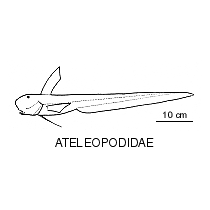- Classification
- ACTINOPTERYGII
- ATELEOPODIFORMES
- ATELEOPODIDAE
-
Fish Classification
-
Class
ACTINOPTERYGII Ray-finned fishes -
Order
ATELEOPODIFORMES Jellynose fishes -
Family
ATELEOPODIDAE Jellynose fishes
Family ATELEOPODIDAE
More Info
|
Family Taxonomy |
A small family of four genera and eleven described species. Two genera and about four species are known from Australian waters, some of which may be undescribed. |
|
Family Distribution |
Widely distributed in tropical and warm-temperate regions of the Atlantic, Indian and Pacific Oceans. Jellynose fishes are benthopelagic on the continental slope. |
|
Family Description |
Head very large, snout bulbous, mouth inferior, body tapering to very small caudal fin in most species. Pelvic fins reduced to one or two elongated rays under the head in adults (except in Guentherius which is not found in Australian waters). Dorsal fin high, short-based, just behind the head, with 3-13 rays. Branchiostegal rays 7. |
|
Family Size |
To 2 m. |
|
Family Feeding |
Carnivores, feeding on small fishes and crustaceans. |
|
Family Commercial |
Although jellynose fishes are taken as bycatch in commercial trawls, they are of no commercial importance. |
|
Family Conservation |
IUCN Red List: Not evaluated |
|
Family Remarks |
An MRI scan of a jellynose fish, Ijimaia antillarum, can be viewed online at the Digital Fish Library. The scientific name is from the Greek atelis meaning imperfect, pus, meaning form and the Latin forma, meaning external form – in reference to the reduced pelvic and pectoral fins of jellynose fishes. |
|
Family Biology |
Jellynose fishes lack a swim bladder and must rely on other ways to maintain neutral buoyancy in the water column. This may be achieved through the mostly cartilaginous skeleton and the watery flesh with large amounts of gelatinous material under the skin. At least one species of jellynose fishes has an aglomerular tubular kidney (gomeruli are the kidney’s filtering structures) that functions to retain water in body tissues, therefore assisting in buoyancy control. |
|
Author |
Dianne J. Bray |
References
Amaoka, K. & T. Kobayashi. 2003. Two large postlarvae of Ateleopus japonicus (Osteichthyes: Ateleopodidae) collected from Senzaki Bay, Yamaguchi, Japan. Spec. Divers 8: 107–117.
Bray, D.J. & D.F. Hoese. 2006. Family Ateleopodidae, In Beesley, P.L. & A. Wells. Zoological Catalogue of Australia Volume 35, Parts 1 – 3. Fishes. CSIRO Publishing / Australian Biological Resources Study (ABRS). 2248 pp.
Digital Fish Library: http://www.digitalfishlibrary.org/library/ViewSpecies.php?id=276 accessed 22 December 2010
Diogo, R. 2008. On the cephalic and pectoral girdle muscles of the deep sea fish Alepocephalus rostratus, with comments on the functional morphology and phylogenetic relationships of the Alepocephaloidei (Teleostei). Anim. Biol. 58(1): 23-29.
Moore, J.A. 1999. Family Ateleopodidae. In Carpenter and Niem (Eds.) Species identification guide for fisheries purposes. The living marine resources of the western central Pacific. Batoid fishes, chimeras and bony fishes part 1 (Elopidae to Linophrynidae). FAO, Rome.
Nelson, J.S. 2006. Fishes of the World. New York : John Wiley & Sons.
Olney, J.E. 1998. Ateleopodiformes, p. 158. In Paxton, J.R. & Eschmeyer, W.N. (eds.) Encyclopedia of Fishes. Academic Press, San Diego.
Olney, J.E., Johnson, G.D. & Baldwin, C.C. 1993. Phylogeny of lampridiform fishes. Bulletin of Marine Science 52: 137-169.
Sasaki, K., Y. Tanaka & Y. Takata. 2006. Cranial morphology of Ateleopus japonicus (Ateleopodidae: Ateleopodiformes), with a discussion on metamorphic mouth migration and lampridiform affinities. Ichthyological Research 53(3): 254-263.



